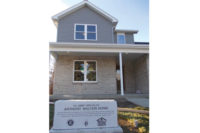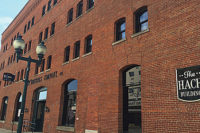The task – write an article with a fresh perspective about fire restoration with baking soda blasting – was seemingly simple. When approaching the task of writing an interesting article for a top-notch restoration magazine, however, an author has to continually ask himself: “Is this topic interesting and relevant?” or better put, “Will the reader find the information interesting, as well as informative and on-target?” When you sit down to write an article, especially a unique, interesting, relevant and on-topic article, it’s easy to find the process daunting. This was exactly the case recently as I approached the writing of this piece. I searched for the right story, the right opinion, the right perspective. It suddenly became clear that the most unique, relevant and on-topic perspective I could have would be the perspective of someone else.
The next moment of clarity came when considering the topic of the article at hand – baking soda blasting for fire and smoke restoration – and whose perspective would be both interesting and relevant. Many of my customers, restoration contractors spread across the nation in widely varying markets, immediately came to mind. Again, many of them would have provided what I was looking for - a unique perspective from a successful restoration contractor using baking soda blasting for fire restoration. I spoke with many of them. In the end, I chose not one of these unique perspectives, but three. These three because they offered another benefit – they were leaders in their market, their organizations, and their understanding of the tools available to today’s restoration contractor. With little prompting, they quickly told of their successes with the process.
Case No. 1: Paul Davis Restoration
Paul Hunter, a leading restoration contractor on the Carolina coast, and owner of Paul Davis Restoration of Wilmington, NC was quick to point out the reason for using baking soda blasting in the restoration of fire damage. He indicated in no uncertain terms that the process is “the fastest and most effective tool available for removing soot and cleaning lightly charred building materials.” He went on to explain that “not only is the blasting process extremely effective at cleaning away the fire damage, but the baking soda media actually deodorizes at the same time.” Although it’s not possible to “show” the deodorization with before and after pictures, it is known that baking soda changes the pH of (or “neutralizes”) the odor-causing soot and fire residue when in contact with each other. Baking soda dust created when blasting is often, and somewhat wrongly, characterized as a disadvantage when using the process for restoration. In actuality, the end product – the massive deodorization resulting from using baking soda blast media – are the real proof of this clear benefit.
When asked if Paul had anything to add to his comments, anything that a restoration contractor new to this process should know, he indicated that “it’s important that you understand how the equipment works. Don’t expect that you can just rent the machine, and all of the sudden you’re an expert. Proper training and support from your supplier, as well as the proper use of the available tools is a top priority.” The use of an axial fan and dust sock for negative air and good visibility is a great example of this thought. It’s not “rocket science.” If you don’t have access to a dust sock or don’t understand its importance, visibility suffers, containment becomes troublesome, and success on the job site less likely. This type of knowledge is much easier to learn through proper training by someone that understands the process, as well as the tools, than by trial and error.
Case No. 2: Servpro
When asked some of the same questions about baking soda blasting for fire restoration Kelly Rousseau, owner of Servpro of Fox Cities in Appleton, WI had some similar responses. Kelly did, however, add an additional comment that the process “saves a lot of demolition and re-construction.” When pressed about the reason that he chooses to use baking soda for fire restoration, Rousseau replied that he has choices, both baking soda and dry ice blasting capabilities. He again points to the fact that “in heat-driven fires, ones where burning and smoldering materials create heavy soot, there is simply no comparison to the ability of baking soda blasting to clean building components.”
Kelly also indicated a firm understanding of the “need for containment and excellent negative air arrangements.” In addition, he recognized the advantage of using the process outside of containment, literally. Kelly provided pictures (see image 3) of a fire loss restoration project at an elementary school in his area, which vividly document the ability of baking soda blasting to be used on the exterior of fire damaged structures. When used in this manner, water is used at the nozzle to very effectively control process dust. When finished with this type of blasting, water can also be used to rinse and “clean up” the water soluble media.
Case No. 3: Puroclean Disaster Restoration
Another leading restorer located in Martinsburg, WV is Puroclean Disaster Restoration, and owner Rodney Trenary. His familiarity with many types of blasting was immediately apparent – having owned both baking soda and dry ice blasting for several years. Rodney indicated a strong preference for using baking soda blasting on fire restoration (see image 4) citing several important factors. The first factor he mentioned was “the superior finish achieved with baking soda blasting on wood and other surfaces. The process creates more of a ‘sanded finish’ on the surface, wood in particular.” It’s easy to see the type of finish he’s referring to in the test result pictures showing baking soda and dry ice blasting at 60 psi on the same piece of wood. He also went on to recognize “the ability to deodorize. Baking soda fills the structure with baking soda dust, beneficial dust that deodorizes. We end up cleaning after blasting no matter what method we use.” Surprisingly, the final factor leading to his choice of baking soda as the tool of choice for fire restoration was “logistics - plain and simple. We get dry ice in 500-pound bins.” He went on the elaborate, “These bins (see image 5) are heavy and difficult to deal with at times.” Indeed, the returnable bins are somewhat of a hassle. The bigger issue, however, was highlighted by his next remark: “In our area we also worry about dry ice freshness.” Dry ice is perishable, with a shelf life of less than one week from the day it’s made. Couple this with a loss of effectiveness through the blaster with each passing day, and it’s easy to see why freshness is a major concern when blasting with dry ice.
I’d like to thank the contractors that participated in my informal survey of their trade. I appreciate their unique perspectives. After spending some time with many of them, both on the phone and in person, it’s easy to see that baking soda blasting for fire restoration is the leading edge of fire restoration technology. Ultimately the test that all cleaning processes must pass is the challenge to be effective both in its application and its results. Baking soda blasting for fire restoration has done just that.








Report Abusive Comment